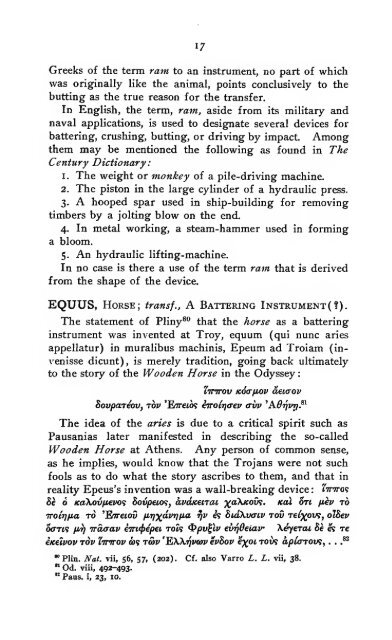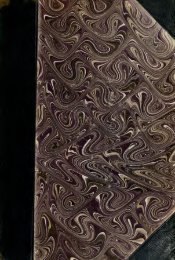Figurative uses of animal names in Latin and their ... - mura di tutti
Figurative uses of animal names in Latin and their ... - mura di tutti
Figurative uses of animal names in Latin and their ... - mura di tutti
You also want an ePaper? Increase the reach of your titles
YUMPU automatically turns print PDFs into web optimized ePapers that Google loves.
:<br />
17<br />
Greeks <strong>of</strong> the term ram to an <strong>in</strong>strument, no part <strong>of</strong> which<br />
was orig<strong>in</strong>ally like the <strong>animal</strong>, po<strong>in</strong>ts conclusively to the<br />
butt<strong>in</strong>g as the true reason for the transfer.<br />
In English, the term, ram, aside from its military <strong>and</strong><br />
naval applications, is used to designate several devices for<br />
batter<strong>in</strong>g, crush<strong>in</strong>g, butt<strong>in</strong>g, or driv<strong>in</strong>g by impact. Among<br />
them may be mentioned the follow<strong>in</strong>g as found <strong>in</strong> The<br />
Century Dictionary<br />
1. The weight or monkey <strong>of</strong> a pile-driv<strong>in</strong>g mach<strong>in</strong>e.<br />
2. The piston <strong>in</strong> the large cyl<strong>in</strong>der <strong>of</strong> a hydraulic press.<br />
3. A hooped spar used <strong>in</strong> ship-build<strong>in</strong>g for remov<strong>in</strong>g<br />
timbers by a jolt<strong>in</strong>g blow on the end.<br />
4. In metal work<strong>in</strong>g, a steam-hammer used <strong>in</strong> form<strong>in</strong>g<br />
a bloom.<br />
5. An hydraulic lift<strong>in</strong>g-mach<strong>in</strong>e.<br />
In no case is there a use <strong>of</strong> the term ram that is derived<br />
from the shape <strong>of</strong> the device.<br />
EQUUS, Horse; transf., A Batter<strong>in</strong>g iNSTRUMENT(f).<br />
The statement <strong>of</strong> Pl<strong>in</strong>y®" that the horse as a batter<strong>in</strong>g<br />
<strong>in</strong>strument was <strong>in</strong>vented at Troy, equum (qui nunc aries<br />
appellatur) <strong>in</strong> <strong>mura</strong>libus mach<strong>in</strong>is, Epeum ad Troiam (<strong>in</strong>-<br />
venisse <strong>di</strong>cunt), is merely tra<strong>di</strong>tion, go<strong>in</strong>g back ultimately<br />
to the story <strong>of</strong> the Wooden Horse <strong>in</strong> the Odyssey<br />
X<strong>in</strong>rov Koafiov aeurov<br />
Sovpareov, rbv 'Ettcw? hroiqaev trw ''A.Orjvri?^<br />
The idea <strong>of</strong> the aries is due to a critical spirit such as<br />
Pausanias later manifested <strong>in</strong> describ<strong>in</strong>g the so-called<br />
Wooden Horse at Athens. Any person <strong>of</strong> common sense,<br />
as he implies, would know that the Trojans were not such<br />
fools as to do what the story ascribes to them, <strong>and</strong> that <strong>in</strong><br />
reality Epeus's <strong>in</strong>vention was a wall-break<strong>in</strong>g device :<br />
:<br />
itttto?<br />
he 6 ica\ov/i€vo^ hovpeio'i, aveuceirai ^^aXxoO?. xal on fiev ro<br />
"jToirjua ro 'ETretou fii)j(^dv7}na rp/ e? hiaXvaiv tov reixovi, olSep<br />
ocTTK fii] traa-av hri^epei rots ^pv^lv evijdeiav Xeyerai Se e; re<br />
eKelvov TOV X<strong>in</strong>rov a>? r&v '^Wrivtov evhov ej(pi rois apiarovi, . . .'^<br />
"Pl<strong>in</strong>. Nat. vii, 56. S7f (202). Cf. also Varro L. L. vii, 38.<br />
" Od. viii, 492-493.<br />
" Pans, i, 23, 10.



![Das Kriegswesen der Alten [microform] - mura di tutti](https://img.yumpu.com/21606999/1/167x260/das-kriegswesen-der-alten-microform-mura-di-tutti.jpg?quality=85)








